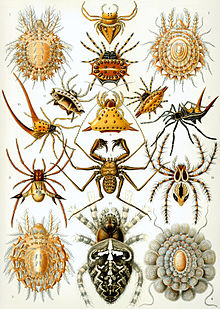Arachnids are the largest and most well known class of the Chelicerata with around 65,000 described species. Members of Arachnida can be found on every continent. There are 11 subgroups that most authorities recognize, but the level of classification and some names are not always agrees upon.
"Arachnida" from Ernst Haeckel's Kunstformen der Natur , 1904
Glossary for this page (all links are to Wikipedia articles)
Chelicera
Filiform
Opisthosoma
Pedipalp
Petiolate
Prosoma
Spinneret
Suture
Tarsus
Tubercle
Key to the Orders of Arachnida
edit
1 : Opisthosoma clearly segmented, spinnerets absent2 : Opisthosoma not segmented or if segmented, spinnerets present on ventral posterior side
3 : Opisthosoma has a tail-like elongation, either thick with a sting or thin and whiplike; Usually tropical.6 : Opisthosoma lacking tail-like elongatio, or only with a very short appendage.
Scorpiones : Opisthosoma ending in a sting; First pair of legs not greatly elongated.4 : Opisthosoma not ending in a sting; First pair of legs longer than other pairs.
Palpigradi : Pedipalps similar in size to legs; Less than 5 millimeters in length.5 : Pedipalps usually much stouter than legs; Usually larger than 5 millimeters in length.
Uropygi : Eyes present; Tail long and with many segments; Body blackish and at least 50 millimeters in length.Schizomida : Eyes absent; Tail short with one to four segments; Body brownish to yellowish and less than 8 millimeters in length.
Pseudoscorpiones : Pedipalps pincerlike; Body more or less oval and flattened; Usually less than 5 millimeters in length.7 : Pedipalps leglike or different, but not pincerlike.
Solifugae : Chelicerae very large and extending forward; Body yellow to brownish and 20 to 30 millimeters in length.8 : With different combination of characters.
9 : First pair of legs and tarsi very long; Opisthosoma constricted at the base; Mostly tropical.10 : First pair of legs similar to others; Opisthosoma not obviously constricted at the base.
Schizomida : Prosoma longer than wide; Opisthosoma with a minute terminal appendage; 5 to 8 millimeters in length.Amblypygi : Prosoma wider than long; Opisthosoma without a minute terminal appendage; Body length variable.
Ricinulei : Broad flap at anterior end of prosoma concealing chelicerae; Legs not unusually long; Somewhat mite-like or tick-like.Opiliones : Broad flap covering chelicerae absent; Legs often very long and slender. 